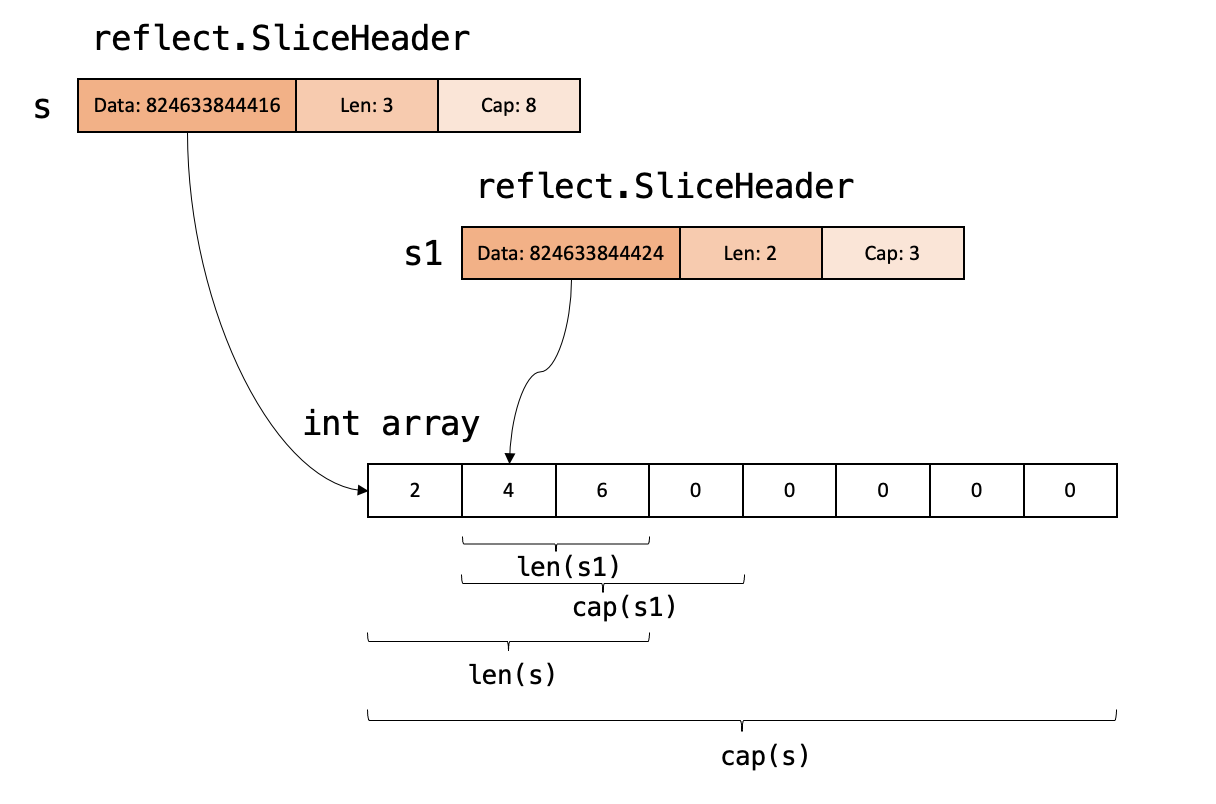Go源码学习: 切片slice的内部数据结构
📅 2021-11-16 | 🖱️
Go语言中的切片slice的底层数据结构是数组,这是即使是Go的初学者都了解的。
前面我们学习了string类型在运行时由reflect.StringHeader表示,StringHeader可以理解为string在运行时的"描述符",StringHeader由Data和Len两个字段组成,Data是指向string底层byte数组的指针,Len是string的长度。
string的底层实现是byte数组,切片slice的底层实现也是数组,可以看出在Go语言中数组更多的是作为底层存存储实现的角色,在日常开发中我们直接使用数组的场景很少,更多的是使用slice。本节将学习切片slice在运行时的描述符reflect.SliceHeader。
切片在运行时的描述符reflect.SliceHeader #
slice在Go中的内部结构是reflect.SliceHeader,位于reflect/value.go中:
1// SliceHeader is the runtime representation of a slice.
2// It cannot be used safely or portably and its representation may
3// change in a later release.
4// Moreover, the Data field is not sufficient to guarantee the data
5// it references will not be garbage collected, so programs must keep
6// a separate, correctly typed pointer to the underlying data.
7type SliceHeader struct {
8 Data uintptr
9 Len int
10 Cap int
11}
从SliceHeader的注释中可以看出: SliceHeader是slice在运行时的表示形式,也就是前面说的“描述符”。
SliceHeader它本身不存储slice的数据,而只包含一个指向slice底层数组的指针(Data uinptr)、一个表示当前切片长度的int字段(Len int)、一个表示当前切片容量的字段Cap int。即:
- Data: 是指向底层数组的指针
- Len: 是切片的长度,即切片中元素的个数
- Cap: 是切片的最大容量,
Len <= Cap
再对比一下string在运行时的描述符StringHeader代码:
1type StringHeader struct {
2 Data uintptr
3 Len int
4}
可以看到StringHeader只比SliceHeader少了一个Cap字段,因为string具有不可变性,不能直接向底层数组追加元素,所以不需要Cap,因此有经常有人会说字符串string是一个元素类型为byte的只读的切片类型。
对比了SliceHeade和StringHeader之后,下面我们进入正题,下面的代码通过使用unsafe.Pointer的转换能力逐步得到SliceHeader和slice的底层数组结构,并将它们打印出来。
1package main
2
3import (
4 "fmt"
5 "reflect"
6 "unsafe"
7)
8
9func main() {
10 s := make([]int, 0, 8)
11 s = append(s, 2, 4, 6)
12 sh := (*reflect.SliceHeader)(unsafe.Pointer(&s))
13 fmt.Printf("%+v\n", sh) // &{Data:824633844416 Len:3 Cap:8}
14 ap := (*[8]int)(unsafe.Pointer(sh.Data))
15 fmt.Println(ap) // &[2 4 6 0 0 0 0 0]
16
17 s1 := s[1:3:4]
18 sh1 := (*reflect.SliceHeader)(unsafe.Pointer(&s1))
19 fmt.Printf("%+v\n", sh1) // &{Data:824633844424 Len:2 Cap:3}
20 ap1 := (*[8]int)(unsafe.Pointer(sh.Data))
21 fmt.Println(ap1) // &[2 4 6 0 0 0 0 0]
22}
上面的代码中切片s通过make函数创建,切片s1同构对切片s执行切片操作创建。这两个切片底层内存表示示意如下图:

上图中的切片s和切片s1共享同一个底层数组,因此不管是谁对底层数组的修改都会反映到其他切片中。
runtime.makeslice #
下面看一下使用make函数创建切片时的具体实现,当使用make函数创建切片时,例如s := make([]int, 0, 8),实际上调用的是go运行时的runtime.makeslice这个函数。slice是由Go的编译器和运行时联合实现的数据类型。
runtime.makeslice函数的签名如下:
1> runtime.makeslice() /usr/local/Cellar/go/1.17.2/libexec/src/runtime/slice.go:83 (hits goroutine(1):1 total:1) (PC: 0x1047d2a)
2 82:
3=> 83: func makeslice(et *_type, len, cap int) unsafe.Pointer {
4 84: mem, overflow := math.MulUintptr(et.size, uintptr(cap))
makeslice函数有三个参数: et对应切片中元素类型,len为切片的长度,cap为切片的容量。
这个函数十分简单,主要是通过调用math.MulUintptr判断内存申请,计算当前切片占用的内存空间,最后在堆上申请一块连续的内存空间,内存空间的大小为切片元素类型大小et.size乘以切片容量cap。在计算占用内存空间时有内存是否溢出(要分配的内存是否大于寻址空间)的判断。
1func makeslice(et *_type, len, cap int) unsafe.Pointer {
2 mem, overflow := math.MulUintptr(et.size, uintptr(cap))
3 if overflow || mem > maxAlloc || len < 0 || len > cap {
4 // NOTE: Produce a 'len out of range' error instead of a
5 // 'cap out of range' error when someone does make([]T, bignumber).
6 // 'cap out of range' is true too, but since the cap is only being
7 // supplied implicitly, saying len is clearer.
8 // See golang.org/issue/4085.
9 mem, overflow := math.MulUintptr(et.size, uintptr(len))
10 if overflow || mem > maxAlloc || len < 0 {
11 panicmakeslicelen()
12 }
13 panicmakeslicecap()
14 }
15
16 return mallocgc(mem, et, true)
17}
makeslice返回的就是指向底层数组的指针(unsafe.Pointer)。在调用makeslice函数时如果内存空间的大小发生了溢出(要分配的内存大于寻址空间)、或者传入切片长度len小于0,或者传入的切片容量cap小于len都会panic。